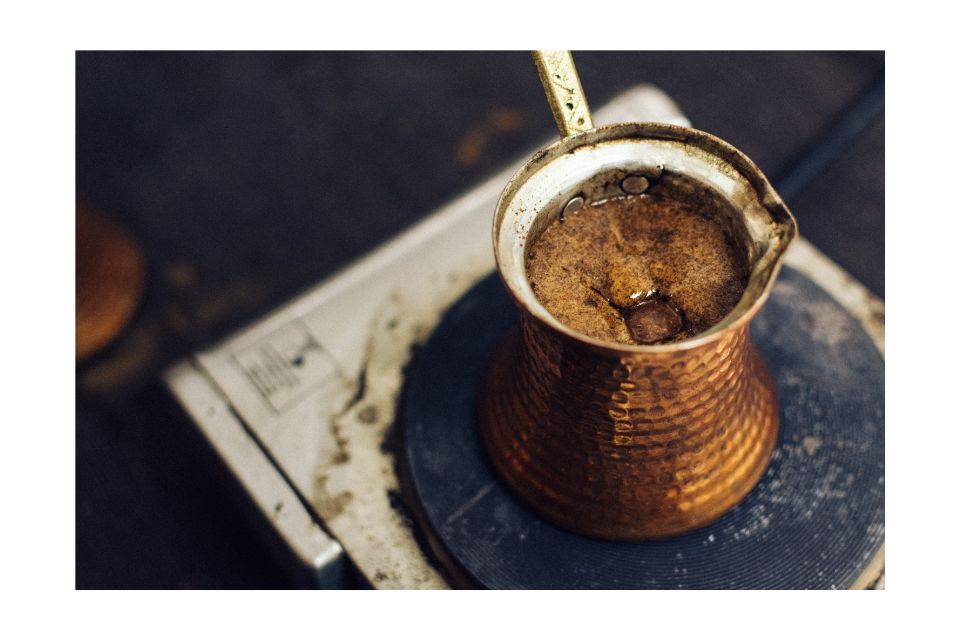Struggling to replicate the rich taste of authentic Turkish coffee at home? Trust me, I’ve been there – this unique brewing method used since the 15th century can be tricky to get right. With careful research and a few trials, I’ve discovered the secrets to perfecting this traditional treat.
So let’s dive into making your very own Turkish coffee that rivals any café experience!
Key Takeaways
- The key ingredients needed to make Turkish coffee include finely ground Turkish coffee, a cezve (Turkish coffee pot), sugar (optional), spices like cardamom or cinnamon (optional), freshwater, small espresso-sized cups, and Turkish delights for serving.
- To brew the perfect cup of Turkish coffee, use a fine grind for maximum flavor extraction, control the heat and timing carefully by starting on low heat and gradually increasing it, and aim for a thick foam on top during brewing.
- Adding flavor to your Turkish coffee can be done by adding sugar directly to the cezve while brewing or experimenting with different spices like cardamom or cinnamon.
- When serving Turkish coffee, present it in traditional porcelain cups known as “fin can” on intricately patterned saucers. Pairing the coffee with some delicious Turkish delights enhances the overall experience.
Steps to Make Turkish Coffee
To make authentic Turkish coffee, start by adding finely ground coffee and optional sugar or spices to a cezve.
Ingredients needed
To get started with your authentic Turkish coffee journey, there are a few key ingredients you need to have on hand. First and foremost, you’ll need freshly ground Turkish coffee that is powder-like in texture. You can do this by using a specific Turkish coffee grinder or buying pre-ground beans. A traditional copper coffee pot called a cezve is the main tool for brewing. It’s important to note that these pots come in different sizes based on the number of cups served, so choose accordingly.
- Freshly ground Turkish coffee
- A cezve (Turkish coffee pot)
- Sugar (optional)
- Spices like cardamom or cinnamon (optional)
- Fresh water
- Small espresso-sized cups
- Turkish delights (for serving)
Brewing process
To make Turkish coffee, you will need a few key ingredients and follow a specific brewing process. Here’s how to brew the perfect cup of Turkish coffee:
- Gather your supplies: You will need a cezve (a small copper coffee pot), finely ground Turkish coffee, water, and optional sugar or spices for flavor.
- Measure the ingredients: For each cup of coffee, use one heaping teaspoon of ground coffee and one demitasse cup (about 3 ounces) of water. Adjust the amount according to your taste preference.
- Add the coffee to the cezve: Place the cezve on low heat and add the ground coffee. If desired, add sugar or spices at this stage.
- Start heating slowly: Slowly heat the cezve, stirring constantly to prevent clumps from forming. Be careful not to let it boil too quickly.
- Bring it to a boil gradually: As you continue stirring, bring the mixture to a gentle boil over low heat. Watch out for foam forming on top – this is an important part of Turkish coffee.
- Control the timing: Just before it boils over, remove the cezve from heat for a few seconds to let it cool down slightly.
- Repeat the boiling process: Return the cezve back onto low heat and let it come close to boiling again while stirring gently. Remove from heat again just before it boils over.
- Serve with foam intact: Pour your brewed Turkish coffee into small espresso cups using a spoon or ladle, making sure not to disturb the foam on top.
- Use a fine grind for best results since Turkish coffee is unfiltered.
- Control the heat throughout the brewing process by keeping it low.
- Timing is crucial – don’t rush or let it boil too quickly.
- The foam adds richness and texture to the coffee.
- Turkish coffee is traditionally served in small cups and enjoyed slowly.
Adding flavor
When it comes to adding flavor to your Turkish coffee, there are a few options you can explore. One popular choice is to add sugar directly to the cezve while brewing the coffee. This allows the sugar to dissolve and infuse the beverage with sweetness right from the start.
You can adjust the amount of sugar according to your taste preference, whether you prefer a lightly sweetened or strong and robust flavor.
Additionally, you can also experiment with different spices and flavors to enhance your Turkish coffee experience. Common additions include cardamom, which adds a warm and aromatic touch, or cinnamon for a hint of sweetness and depth.
Simply sprinkle these spices into the cezve along with the ground coffee before brewing.
Tips for Making the Perfect Turkish Coffee
To make the perfect Turkish coffee, use the right grind, control the heat and timing carefully, and aim for that thick foam on top.
Using the right grind
For a perfect cup of Turkish coffee, using the right grind is crucial. The coffee beans should be ground to a powder-like consistency, even finer than espresso. This fine grind allows for maximum extraction of flavor and aroma during the brewing process.
If the grind is too coarse, the coffee will taste weak and watery. On the other hand, if it’s too fine, you may end up with a bitter and over-extracted brew. To achieve the ideal grind size for Turkish coffee, it’s recommended to use a specialized grinder or have your beans ground at a reputable coffee shop that understands this unique brewing method.
Investing in a good quality grinder can make all the difference in elevating your Turkish coffee experience to new heights.
Controlling heat and timing
Controlling the heat and timing is crucial when making Turkish coffee to achieve that perfect rich and aromatic flavor. The key is to start with low heat and gradually increase it throughout the brewing process.
This slow heating allows the flavors of the coffee to develop fully without burning or over-extracting.
Timing is equally important as it determines the strength of your coffee. Once you’ve added water to your cezve, let it simmer on low heat for about 2-3 minutes before removing from heat. This ensures that all the flavors are properly infused into the brew.
Achieving the thick foam
To achieve the perfect thick foam on your Turkish coffee, it’s important to follow a few key steps. First, use fresh and finely ground coffee beans specifically made for Turkish coffee. The texture should be almost like powder, as this allows the foam to form easily during brewing.
Next, add cold water to your cezve (the traditional copper pot) along with the desired amount of ground coffee and optional sugar or spices. Gently stir everything together until well combined and no clumps remain.
When it comes to heating, you’ll want to maintain a low flame or heat source throughout the brewing process. This slow and steady approach helps create that signature foam without boiling over or scorching the coffee grounds.
While heating, resist the urge to stir again as this can disrupt the formation of foam. Instead, keep a close eye on your cezve and remove it from heat just before it starts bubbling up excessively.
Pouring is another crucial step in achieving that rich foam layer. Hold back some of the liquid while pouring into each cup so that any remaining residue settles at the bottom of the cezve instead of ending up in your cups.
Serving Turkish Coffee
When serving Turkish coffee, make sure to present it in the traditional way with a small cup and saucer. Don’t forget to pair it with some delicious Turkish delights for an authentic experience.
And if you’re feeling adventurous, try your hand at Turkish coffee reading to uncover your fortune. Curious about the brewing process? Keep reading!
Traditional presentation
When it comes to Turkish coffee, the presentation is just as important as the taste. Traditionally, Turkish coffee is served in small porcelain cups known as “fincan.” These fincans are specifically designed for Turkish coffee with their elegant and delicate shape.
The cups are typically placed on intricately patterned saucers that complement the overall aesthetic. The presentation also includes a small glass of water and sometimes a piece of lokum or Turkish delight on the side.
This attention to detail not only adds to the visual appeal but also enhances the entire experience of enjoying this centuries-old beverage. So, take your time to set up your Turkish coffee table with care and appreciate the tradition behind every sip.
Pairing with Turkish delights
When enjoying a cup of authentic Turkish coffee at home, it’s always a delightful experience to pair it with some traditional Turkish delights. These small, sweet treats perfectly complement the rich and intense flavors of the coffee.
Whether you choose lokum (Turkish delight), baklava, or other confections, the combination is sure to please your taste buds. The soft and chewy texture of Turkish delights adds a pleasant contrast to the boldness of the coffee, while their sweetness enhances its robust flavor.
So go ahead and indulge in this delightful pairing as you sip on your cup of aromatic Turkish coffee – it’s an experience that will transport you straight to the vibrant streets of Istanbul.
Turkish Coffee (With Ibrik and Saucepan Instructions)
Turkish coffee is a rich, traditional style of coffee that is deeply embedded in Turkish culture. It’s a unique coffee drink that many Turkish people enjoy daily, often alongside a sweet treat like Turkish delight. If you’re looking to try Turkish coffee, you don’t need to travel far. You can learn how to make Turkish coffee at home with step-by-step instructions, even without an Ibrik.
The Traditional Coffee Pot: Cezve or Ibrik
Cezve Ibrik Briki Stovetop Coffee Maker
12 Oz Copper Turkish Greek Arabic Coffee Pot with Wooden Handle
- includes: Copper Turkish coffee pot (made in Turkey) and wooden spoon
- Thick & Durable: Created with the passion of talented craftsmen, 2mm thickness (built for maximum durability) 100% hand-hammered real copper (food-safe tin lined)
- Unique & Traditional: Wooden handle for comfortable use, engraved floral pattern for a stylish finish (compatible with gas, electric, and ceramic cookers). Coffee lover’s choice, high quality and authentic, suitable for long-time use
The traditional coffee pot used for making Turkish coffee is known as a cezve or ibrik. However, if you don’t have an ibrik, you can use a small saucepan as a substitute. The coffee brewing method is straightforward and doesn’t require fancy coffee makers or home coffee grinders.
Preparing Your Turkish Coffee
First, measure out your coffee and water. For one coffee, use a heaping tablespoon of ground coffee per small cup of water. Pre-ground Turkish coffee is usually the best choice, but if you’re buying coffee, look for finely ground Arabica coffee.
Place the coffee and sugar (if desired) into the ibrik or saucepan. Then, add cold water. Turkish coffee is often made sweet, so don’t hesitate to add sugar. Stir the mixture until the coffee and sugar are well combined.
Brewing Your Turkish Coffee
Next, put the ibrik or saucepan on low heat. Let the coffee slowly come to a boil. As the coffee comes to a boil, a frothy layer will form on top. This is a good sign that your Turkish coffee is brewing correctly.
Once the froth has risen, remove the ibrik from the heat. Pour a little bit of the frothy coffee into the cups, then return the ibrik to the heat. This process, known as bringing the coffee back, is repeated a few times until the coffee has settled and is ready to be served.
Serving Your Turkish Coffee
Pour the coffee into the cups, ensuring each cup gets an equal amount of froth. Turkish coffee is often served in small cups, similar to espresso.
Turkish coffee might seem similar to French press coffee or pour-over coffee, but it has a unique taste and texture that sets it apart from other types of coffee. The coffee is usually served strong, and it’s customary to finish your coffee, including the grounds at the bottom.
The Turkish Coffee Culture
Drinking the coffee is just as important as making the coffee. Turkish coffee houses are a big part of Turkish coffee culture, where people gather to drink coffee and socialize.
So, if you’re looking for a new coffee brewing method to try, or if you’re a fan of strong, frothy coffee, give Turkish coffee a try. It’s a perfect coffee for those who appreciate the traditional coffee brewing methods and the rich history of coffee culture. And remember, good Turkish coffee is often enjoyed with a sweet treat like Turkish delight.
Turkish coffee reading
One of the unique aspects of Turkish coffee is its connection to fortune telling, also known as “Turkish coffee reading.” After enjoying your cup of Turkish coffee, you can have some fun by interpreting the patterns left in the sediment at the bottom of your cup.
The residue takes on various shapes and symbols that are believed to reveal insights into your future or current situation. It’s a fascinating tradition that adds an element of mystique to the coffee-drinking experience.
As you sip on your delicious Turkish coffee, let your imagination run wild as you study the intricate designs formed by the grounds. Look for symbols such as hearts (symbolizing love), rings (indicating marriage or commitment), or trees (representing growth and prosperity).
Conclusion
In conclusion, making Turkish coffee is not just about the process, but also about embracing a rich cultural tradition. By following the steps and tips outlined in this guide, you can create a cup of authentic Turkish coffee that will delight your taste buds and transport you to the vibrant streets of Istanbul.
So gather your cezve, grind your beans, and savor the experience of brewing a perfect cup of traditional Turkish coffee at home.






One response to “How to make Turkish Coffee Traditionaly”
[…] grinders offer adjustable grinding options from ultra-fine powder making it perfect even for Turkish coffee lovers like myself. However, what’s truly impressive is how user-friendly this machine is. […]